Chefs and tattoos go together like steak and Béarnaise. German chef Christian Bau (b. 1971) is well-known for his two forearm tattoos, both tattooed in 2005, when he was awarded three Michelin stars for his restaurant Schloss Berg (now known as Victor's Fine Dining by Christian Bau). One arm features the classic "trois étoiles", and the other arm also features three stars, representing the three most important women in his life: his wife Yildiz, and their two daughters Lisa Marie and Katharina Sophie.
Bau started his career in the late 80s and received his training solely in Germany. His formative years (1993-1998) were spent in the kitchens of Harald Wohlfahrt's iconic Schwarzwaldstube in the Black Forest, also the place where he met his wife Yildiz. Christian and Yildiz Bau have been running the restaurant at Schloss Berg in Perl-Nennig since 1998, the same year the restaurant got its first Michelin star; the second star followed in 1999. When the restaurant got the three-star accolade, Bau was 34 years old. Shortly after, he met Paul Bocuse for the first time who greeted him with the words: "Welcome to the family" (to be pronounced with a thick French accent... Source: Einblicke by Christian Bau, 2008).
My first visit to Christian Bau's restaurant was in May 2010, and I returned a couple of years later in March 2013; a full review of that visit can be found here. In March 2016 I finally returned to Perl-Nennig for what turned out to be a very special lunch. Special, since Christian Bau had gone to the trouble of composing a special menu, an extended version of the restaurant's current "Paris-Tokyo" menu, which included a number of extra dishes (I hadn't asked, but I did enjoy). Obviously this review is of that special menu, of the meal I had. However, since this menu is not normally on offer in the restaurant, I have chosen, as an exception and to avoid any confusion, to rate the dishes individually and not the meal as a whole.
Lunch kicked off with Christian Bau's signature amuse bouche, cornets with smoked fish cream, beef tartare and caviar, which were as pretty and wonderful as ever, or maybe even better. Arriving at the same time was a superb apple macaron with a foie gras and smoked eel filling.
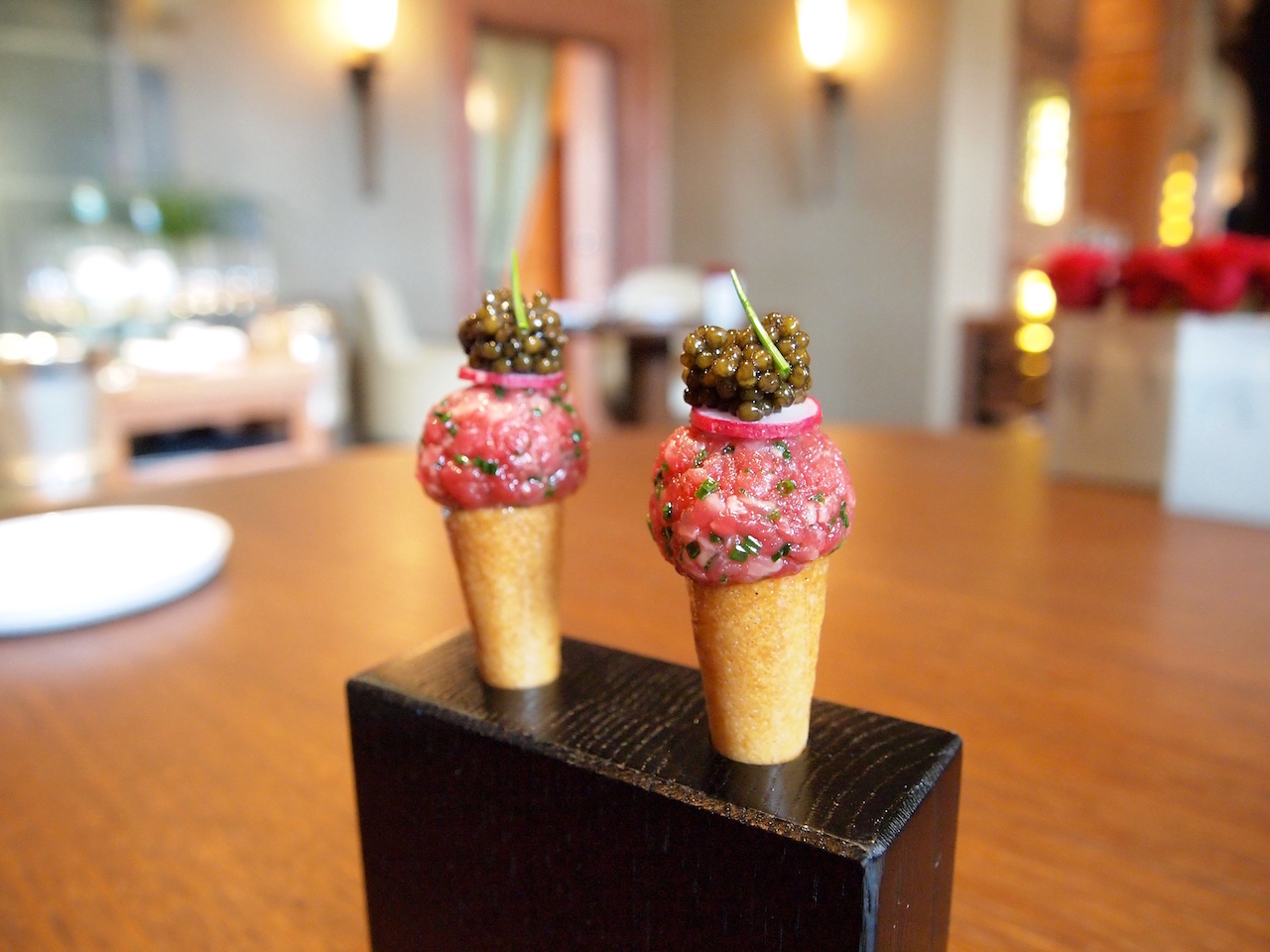
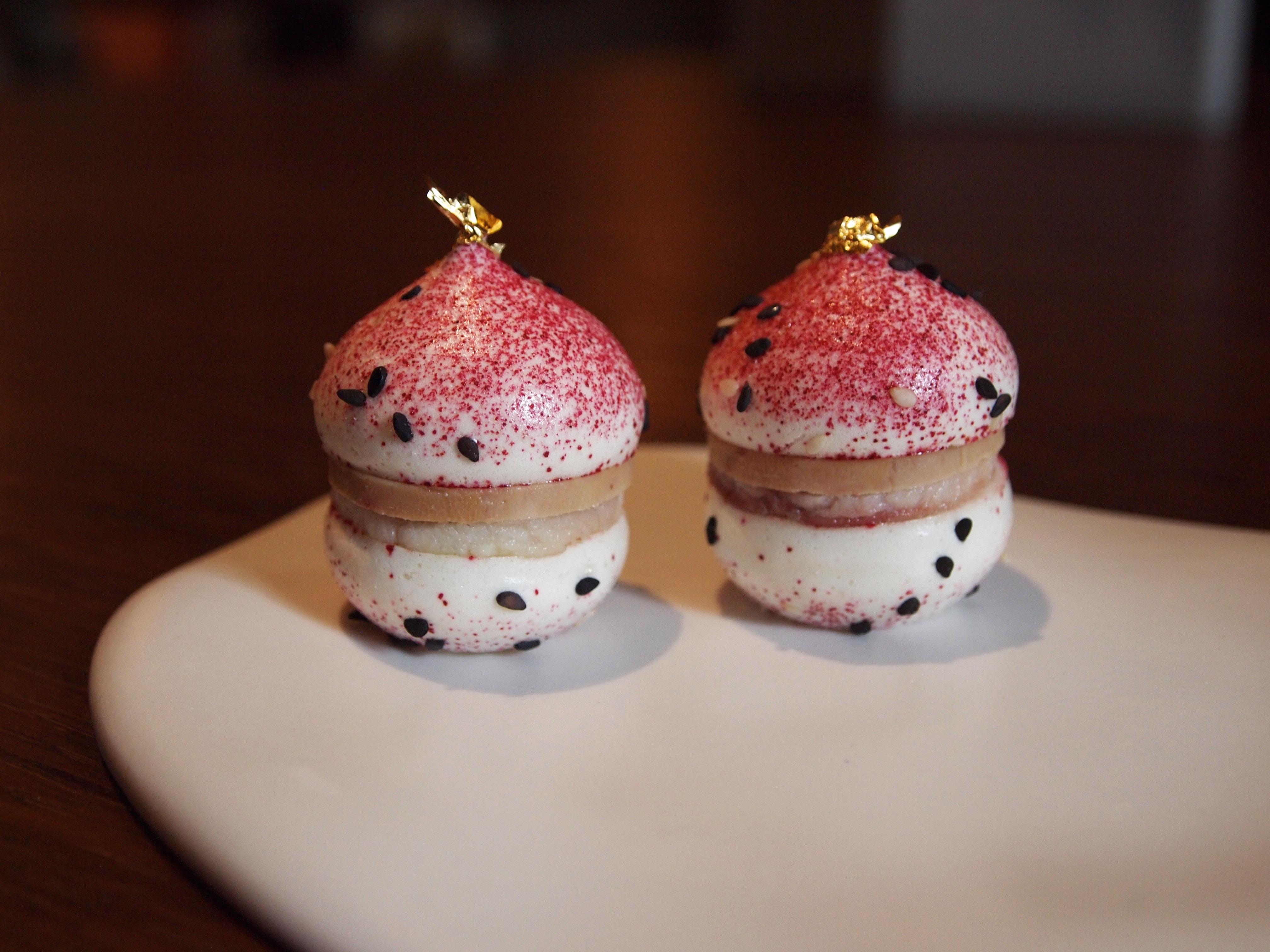
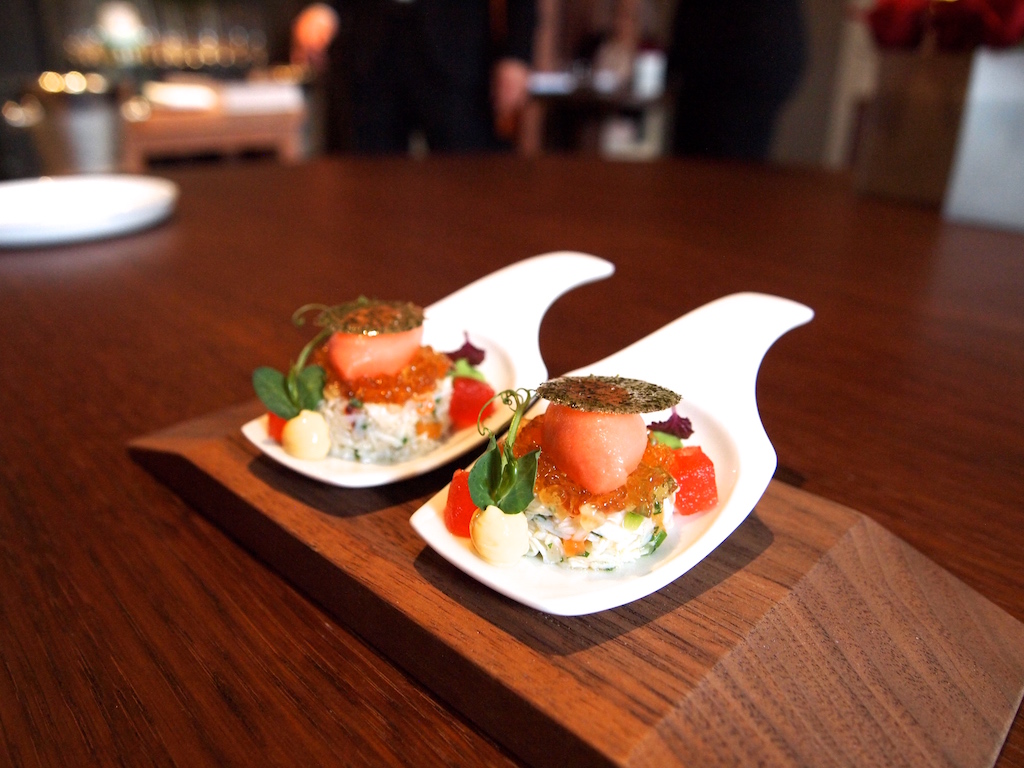

This was followed by two more amuse bouches. A juicy Zeeland oyster was served with a ponzu dressing, ponzu-soy foam, yuzu sorbet, sea vegetables, deep-fried tapioca, a tapioca crisp, oyster-flavoured tapioca pearls, and garnished with finely choped chives. Exquisite oyster, its salty flavours enhanced beautifully by the ponzu dressing and a lovely sharp freshness coming from the yuzu sorbet. Underneath the oyster was some intensely flavoured sea herb puree, which added body to the dish. Last up was a luscious cup of joy with a soft quail's egg yolk at the bottom, topped with wilted spinach, tapioca pearls, baby mushrooms, a delicious Bellota ham foam, and finally a crunchy layer of croutons, ham crumbs and strips of black truffle. A divine combination, the sweet saltiness of the ham coming through beautifully.

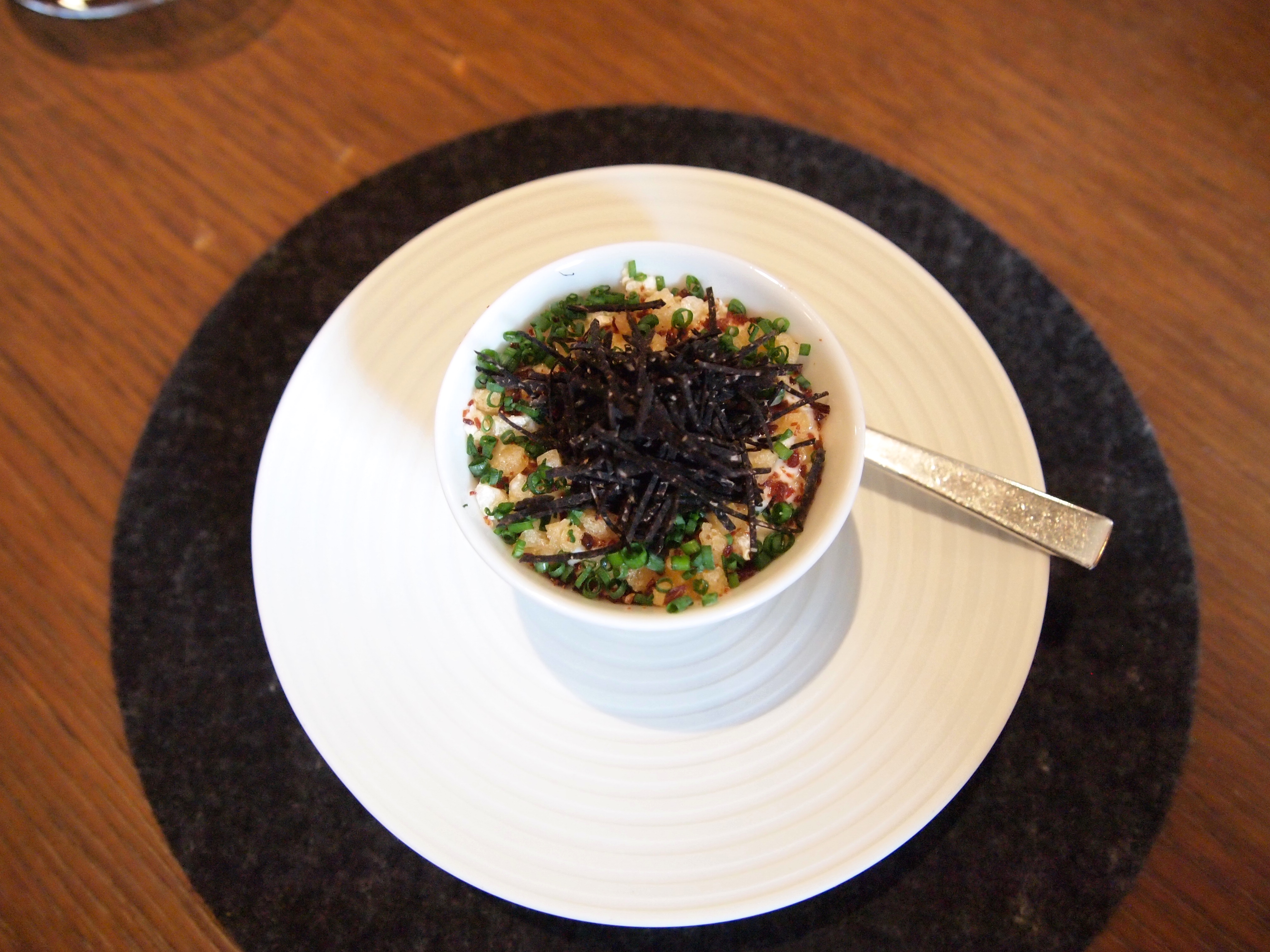
These were six outstanding amuse bouches, particularly the last four, which had great finesse and complexity, the kind that go way beyond their "humble" amuse bouche status. (100/100)
The first course of today's menu was "Stone & Vegetable Garden", a dish that has been on the menu for a number of years now. The last time I enjoyed this dish was in 2013 and then it was a combination of Japanese-style (pickled) vegetables and tuna. The 2016 version is solely composed of (pickled) vegetables. On the (visually stunning!) plate were little chioggia beet cones filled fresh pea halves, miso and yuzu ganache "rocks", little marinated cucumber rolls, iced coriander pearls, ponzu jelly, carrot (yellow, orange and white) rolls stuffed with fresh herbs, a thin slice of crunchy cauliflower, halved crosnes, basil-coriander puree and some kimchi mayonnaise. A supremely attractive dish with that was full of texture and surprise. (100/100)

Second course were three slices of yellowtail belly (lightly marinated in a water-based ginger-lemon grass-kaffir lime marinade), topped with a dot of bergamot gel and crisp bergamot zest, and accompanied by an algae crunch and daikon rolls stuffed with iced bergamot pearls, daikon cress, hijiki seaweed, finished with a green daikon oil. Again, beautifully pure and fresh flavours and the quality of the yellowtail was superb, delicate and mildly fatty. Loved the textural contrast between the yellowtail and the daikon, and the algae crunch offered a nice warm counterpoint. (99/100)
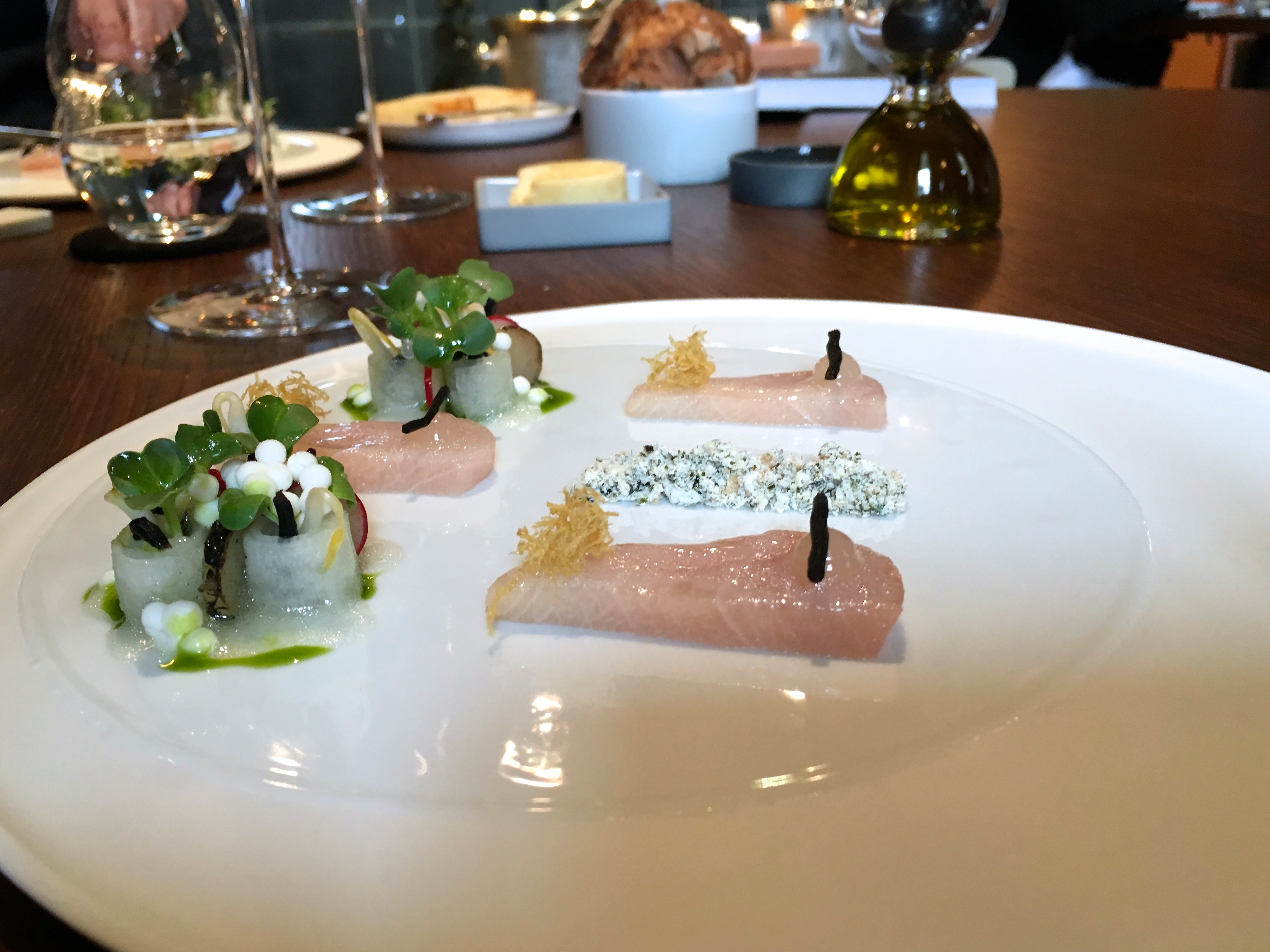
Next up was European bluefin tuna, served in two courses with two different cuts of tuna. To start there was a tuna belly tartare, simply seasoned with finely chopped chives, served on some chopped dashi jelly, and topped with Oscietra caviar. An effortlessly striking and quite sensual dish to eat, with a wonderful interplay of meltingly creamy and fatty flavours, the dashi jelly delivering lovely subtle umami notes. Best of all was the caviar, which highlighted the creaminess/butteriness of the tuna perfectly. (100/100)
The back meat of the tuna (Akami), was used for the next course: tuna tataki and tuna tartare (one served plain, the other one wrapped in cucumber), served with a nice and sharp kaffir lime and black rice vinegar dressing, passion fruit espuma, a passion fruit crisp, a cucumber sorbet, a few little cucumber balls, and some puffed rice for extra crunch. Another outstanding dish that had a great balance between richness, sharpness and freshness, and the kaffir lime provided a wonderful, long finish. (100/100)

After this modern and Japanese start of the menu, the next dish featured more traditional flavours and ingredients. A foie gras praline with a whole hazelnut in the centre and coated with a coffee jelly was served with iced foie pearls, hazelnut crunch and morello cherry puree. A beautiful dish, both to the eye and in flavour. (100/100)

Two gloriously fat green asparagus spears (from Robert Blanc, Villelaure) followed. The asparagus were garnished with a thin strip of miso caramel and edible flower petals. Also on the plate was a miso Hollandaise, little quenelles of candied yuzu zest, and a sprinkling of sumac. The asparagus were exquisite but the combination of flavours was rather on the sweet side. That said, the Hollandaise was expertly made, with a wonderfully frothy and satiny texture, and the miso provided a lovely sweet and salty finish. (98/100).

On to the sixth course: grilled langoustine topped with a very finely chopped mixture of ginger and leeks (seasoned with red chilli), an elegantly Thai-seasoned langoustine tartare, langoustine mayonnaise, and a sauce made with langoustine heads. But there was more: crunchy soy beans, yam puree, coriander puree and a delicious Tom Ka Kai foam. A sensational dish with beautifully infused Thai flavours, that were perfectly judged, and everything was brought together by the intense, bisque-like langoustine head sauce. (100/100)
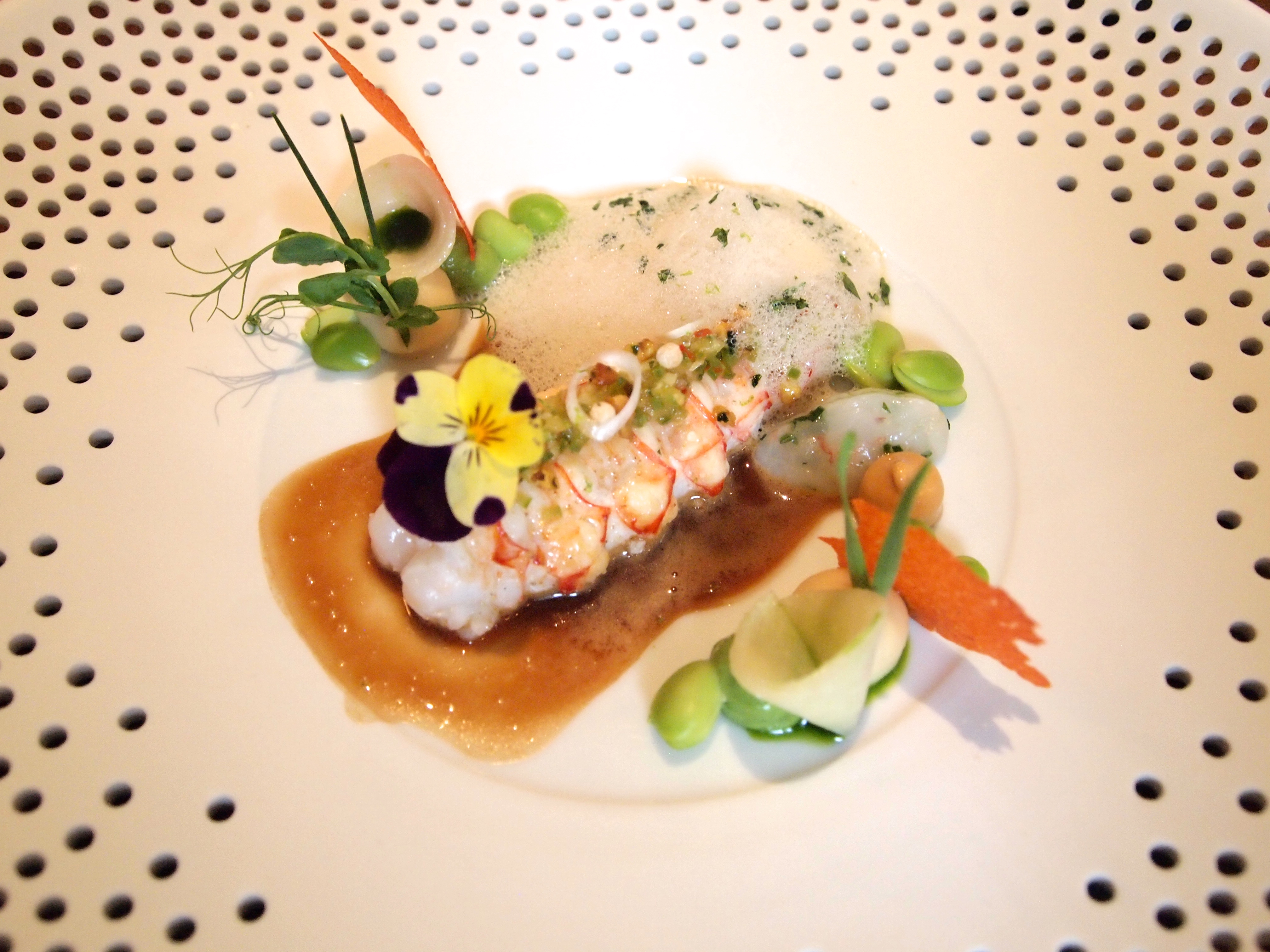
Next up was seabass, topped with grilled baby leeks, deep fried okra rings, and served with barbecued eel, a smooth Japanese aubergine puree, charred baby onions, and a sublime "Kojyu" vinaigrette, seasoned with burnt leek powder and chives. The quality of the seabass was spectacular, perfectly moist and tender and deliciously rich in flavour; one of the finest pieces of seabass I have ever eaten. Equally impressive was the complex vinaigrette that had a good sharpness to it, but there were also some lovely, bittersweet umami notes coming through. An "all guns blazing" kind of dish, the richness of the seabass and eel balanced by the vinaigrette, the aubergine puree softening the sharper flavours. (100/100)
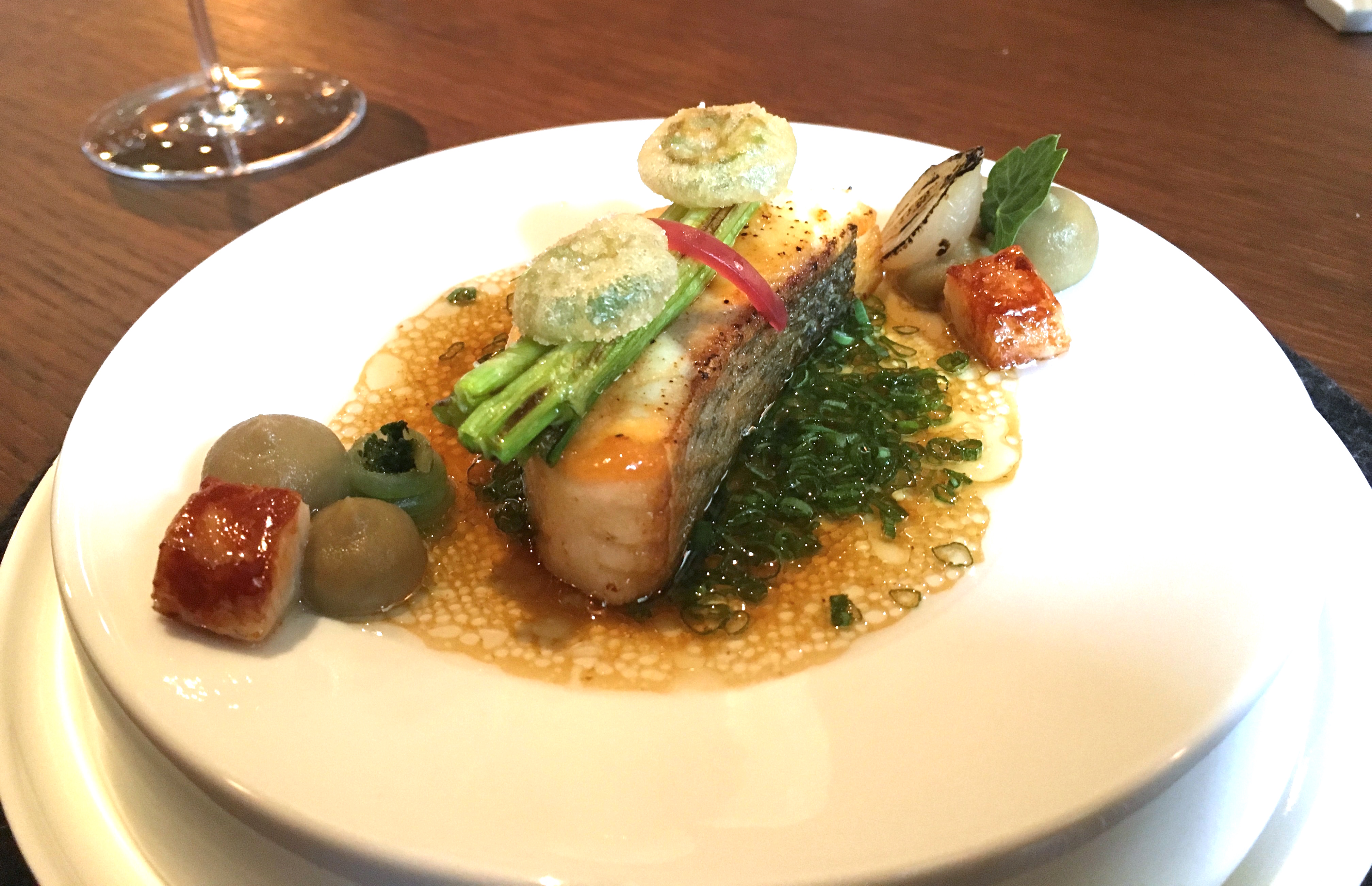
The meal continued with two meat courses. First up was pigeon. Confit leg of pigeon and pigeon breast, accompanied by three preparations of salsify (glazed, crisps, and puree), beetroot, a sandwich with a pigeon offal filling, and finally a rich purple curry sauce. Purple curry is a typical German spice mixture of coriander, mustard, ginger, fennel and mace, amongst others. A refined dish that was well-executed, particularly the pigeon, but not necessarily delivering the same gastronomic dazzle as the previous courses. (98/100).

But the beef that followed made more than up for that. The dish combined two cuts of Japanese Wagyu beef (Miyazaki) and two cooking methods. There was a meltingly tender and not too rich grilled "Schulterscherzel" (flat iron steak) coated with finely chopped chives, and a piece of braised shoulder with a sticky "BBQ Lack" coating. The beef was excellently paired with various textures of corn (espuma, corn bread, baby corn, grilled corn, and corn crumble), braised onion, black garlic créme, and a light ponzu jus. Two immaculate preparations of beef and the sweetness of the corn brought out the delicate sweetness of the beef wonderfully. (100/100)

Time for dessert. To start there was a "Japanese Snowball", an exquisite structure of mango and pineapple "tartare", red shiso sorbet, covered with a white mousse made with Calpico (or Calpis), a Japanese soft drink, and served with an elegantly boozy sake-yuzu juice. A delightful combination with amazingly fresh and intense shiso flavours, the Calpico mousse adding smoothness and creaminess. (99/100)
Winner of the day was the second dessert, a kaleidoscopic act of raspberry and rhubarb. There was rhubarb ice cream, a little rhubarb jelly cube with a milky rhubarb filling, rhubarb-shaped raspberry puree, a fabulous rhubarb tartare lightly seasoned with vanilla, a sphere with a semi-liquid raspberry filling, iced raspberry and some iced buttermilk pearls. A stunning dessert with superb sweet and tart flavours, and displaying the highest level of skill and precision. (100/100)

The third dessert was called "Souvenir from Asia". In the middle of the plate was a square with a pandan leaf and white chocolate ganache filling, a chocolate-praline base, and this was covered with a crisp and thin white chocolate layer, that had a powdery finish. Also on the plate was ginger ice cream, (Nashi) pear puree, and ginger macarons. Lovely floral and creamy sweetness coming from the ganache, the ginger ice cream adding a nice and sharp contrast, and the pear lending a nice fresh touch. (99/100)

What is it they say, it's never that good the second time around? Well, I guess Christian Bau completed a hattrick this afternoon. An off-the-charts, almost daunting meal with often indulgent pairings, where the flavours were dancing off the plate. When Bau was awarded his third Michelin star his cooking was classically French in style, but these days it's heavily Japanese influenced, but still with that all important French basis and with a few German touches thrown in. A style of cooking that he has perfected in the last decade, mainly because of his non-stop quest for inspiration in Asia, and knowledge of Asian ingredients, Japanese in particular. His tremendous attention to detail results in incredibly complex dishes, which he guides with a steady hand to perfect harmony. But above all his cooking is about putting the ingredients in the best light possible, both in flavour and in presentation. Christian Bau is one of the greatest chefs of his generation, with an unsurpassed mastery of his craft. This is the best table in Germany. Full marks.
Disclosure: The principles of my website state that I don't knowingly accept or seek any subsidy in any form. When, at the end of my meal, Yildiz Bau presented me with the bill, I noticed that it included a discount. In the circumstances at the time it would have been an insult to the hospitality of Christian and Yildiz Bau, to refuse this generous gesture, and for that reason, as a rare exception, I felt obliged to accept. I paid my bill and to partially compensate for the discount (and in recognition for the excellent service), I left a very sizeable tip for the team.













